2004 was a momentous year for Canon and their rapidly evolving lineup of digital SLR cameras. In the space of 12 months photographers were treated to two incredible professional tools in the shape of the 1D mark II and 1D mark IIn and also the superb enthusiast level 20D (click for reviews). These cameras were absolutely pivotal in finally prying away photographers of nearly all levels of interest from their film cameras and into the digital world. Furthermore, this had all came hot on the heels of the arrival of the industry disrupting, entry level 300D in late 2003 which had set the benchmark for price, performance and quality.
The death knell was well and truly sounding for film. Surprisingly, then, Canon chose to release one final EOS 35mm film SLR in 2004 – the 300X. At the time, no one was to know that this marked the end of one of the most important eras in photography. Despite being a consumer level camera, the 300X had a lot on its shoulders as the swan song of one of the greatest product lines in photographic history. Let’s see if it really is a deserving send off.
In this review:
- The end of the line
- Wait and eBay shall reward
- Changes from the 300v
- The 300X in use
- Conclusions and learning
The end of the line

Canon hit the jackpot of camera design in 1987 when they launched their revamped film lineup with the EOS 650. They were fashionably late to the auto focus party and had tried to bridge the gap with the slightly odd T series cameras which fused a great deal of electronics with their older FD manual focus lenses. Canon needed something compelling to encourage professionals and amateurs alike to either upgrade or not jump ship to rivals who were offering much more capable ecosystems.
The rest is indeed history as the EOS series became an absolute juggernaut in the market. Canon threw millions into advertising, promotion and famous sponsorship deals, featuring prominently on Nigel Mansell’s world championship winning Williams. At any athletics or football event, the sidelines were awash with the telltale white lenses with the red rings that screamed “you can’t afford this” to amateurs.
Canon didn’t ignore their budget conscious consumers, though. Starting in 1990 with the 1000F, they provided an almost constant stream of capable, well thought out entry level cameras that sold in all the usual electronics outlets like Dixons and catalogue stores such as Argos for very affordable prices. Each iteration offered something more than the previous model, usually more compact bodies, improved ergonomics and auto focus and the addition of LCD displays. I’ve used or reviewed a number of these, such as the 500n, and they are great cameras which leave you wanting for very little.
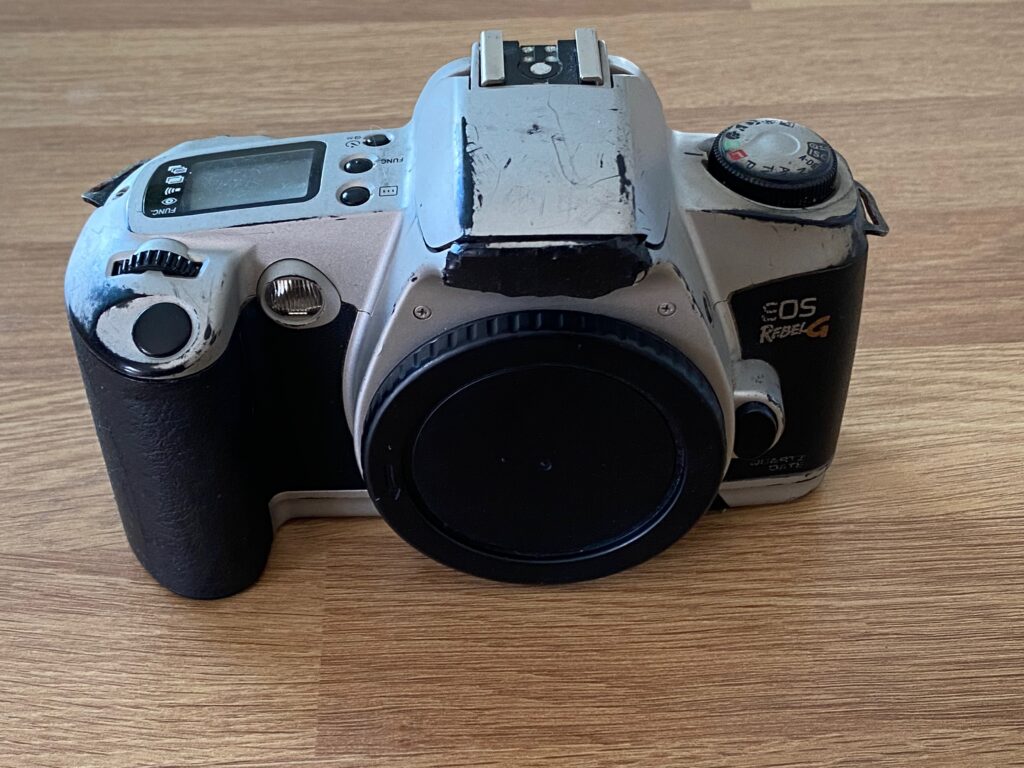
Unlike digital bodies that have quite a lot of genuine differentiation between their feature sets and image quality, film is film. You could buy a £100 entry level SLR, put a decent lens on it and it would produce identical image quality to the £2000 top of the range EOS 1 series. Consequentially, buying an entry level SLR in the 1990’s was a real bargain.
By the time 2004 and the 300X came around, the design and technology in film cameras was as sorted as it was ever going to get. A serious amount of trickle down from the top end bodies meant that even the cheapest, consumer oriented body now had auto film loading, a decent burst fps, AI and one shot auto focus and between 7-9 auto focus points with decent automatic metering. This, at times, led to some almost deliberate crippling or disabling of features to either “help” the user or simply create a difference between models. We saw exactly this with the 300V where Canon made the decision to remove control over the AF mode so it would jump between one shot and AI focus of its own accord.
The 300X changed all of this. Canon knew they weren’t developing any more film bodies and so they carried over the best of the 300V in terms of ergonomics and design and then went further to include the features that were missing before along with some other nice to have custom functions.
Wait and eBay shall reward

I still haven’t worked out why some film bodies command a price premium. Nearly all entry level Canon bodies, the 300V included, go for as little as £5 and at most £15 for one that’s really nice or even boxed. This isn’t the case for the 300X and I’ve been looking for one on and off for a few months now. The sale price I’ve seen some go for defies any kind of logic.
Having waited for a while, it was something of a relief to see one come up on a charity auction. Generally, the large charities are a pretty honest operation on eBay, one of the few sellers where untested really is likely to mean untested and not “guaranteed tested and broken.”
As usual, all I had to go on were the pictures which showed everything seemed to still be in place and nothing was obviously broken. My best guess was because they use odd batteries, they genuinely didn’t have a way of testing the camera before putting it on sale. I put a maximum bid of £25 in and waited for the auction to end. Apparently, no one else fancied risking it and the auction was won for all of £11.

To put this in context, at the time of writing, the only other options for sale were asking anywhere between £85 and £90. A 300V is approximately £15-20. This is beyond absurd – for around £10 more than the asking price of a 300X you could pick up an EOS 1n, why would you choose a 300X over that? What is anyone thinking spending this kind of money on a 20 year old entry level film camera? The mind boggles, yet apparently 13 people are considering it. Madness.
Changes from the 300v
Upon arrival, I poked a couple of batteries in the grip and to the surprise of no one it instantly fired up. I did, however, have completely black hands. The 300X, unlike the 300V, had a rubberised and textured grip. Over time this compound degrades and becomes an absolute sticky nightmare. Fortunately, isopropyl alcohol and some kitchen roll cleans this up in a matter of minutes. You’re left with a completely smooth grip, but in all honesty the textured rubber makes very little difference to the handling – if you really wanted you could always glue some grip back on.
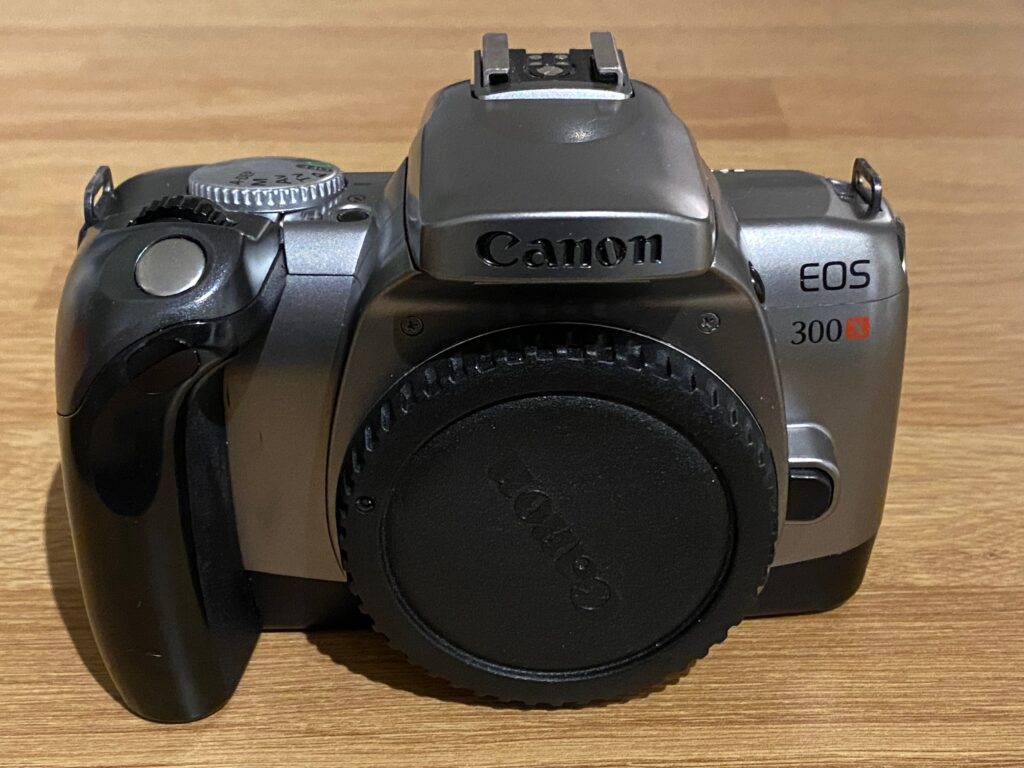
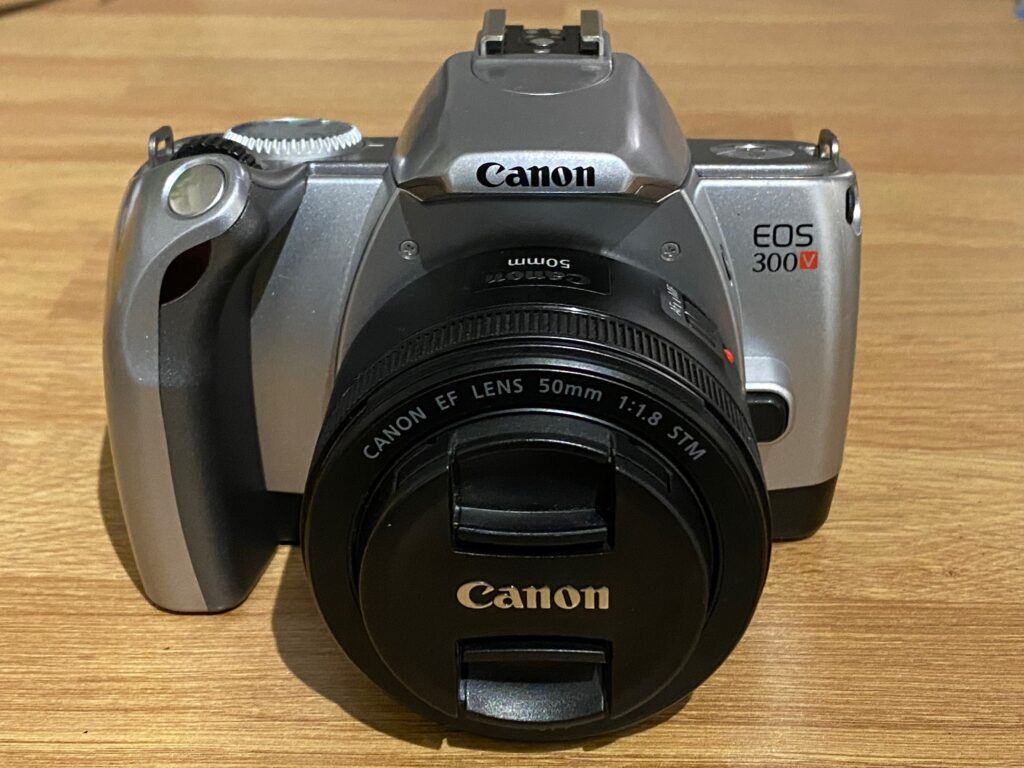
At a glance, both the 300X and its predecessor look almost identical, but it’s not a complete facsimile with a few extra buttons on the back. The most obvious change from the front is the grip which has gained a slightly larger overhang at the top to hook your fingers behind and the shutter button is in a more traditional, flat space on top. In the hand, though, both felt almost identical and you really have to concentrate to notice these subtle changes. If anything, the 300X seems slightly less radical in its design, with some nods towards returning to a more traditional approach to ergonomics.
Other than that, the flash is noticeably larger and more prominent. Whether it is any better or not is a mystery as I never make use of flash, let alone on body pop up flashes. Sorry, flash aficionados…
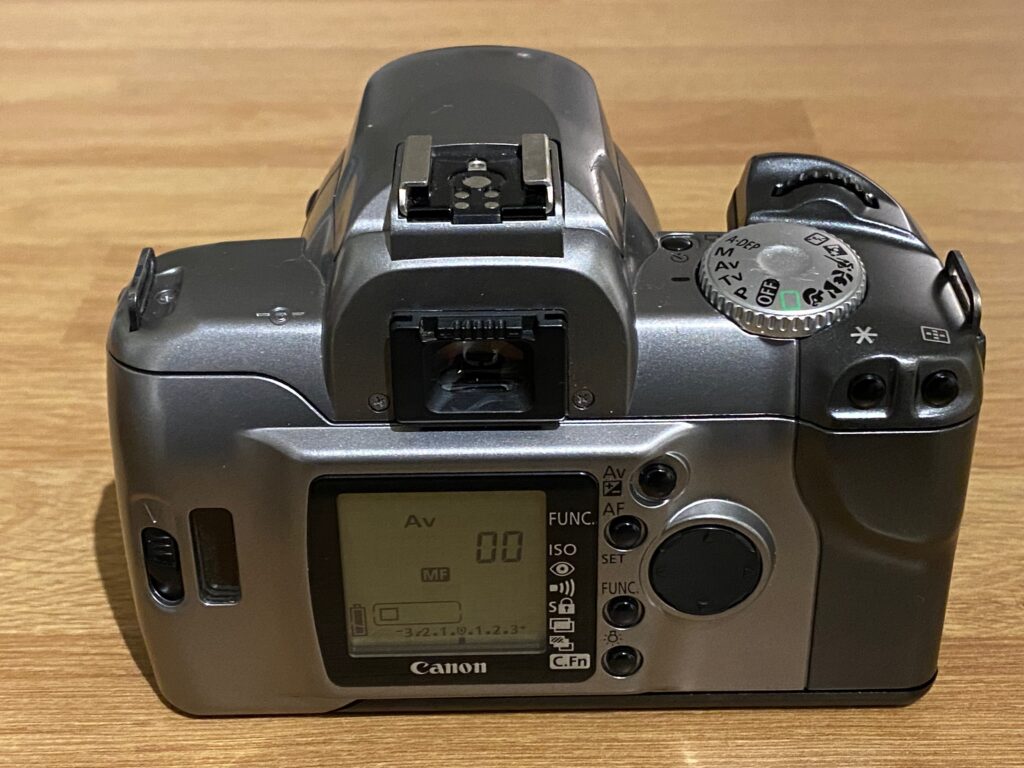
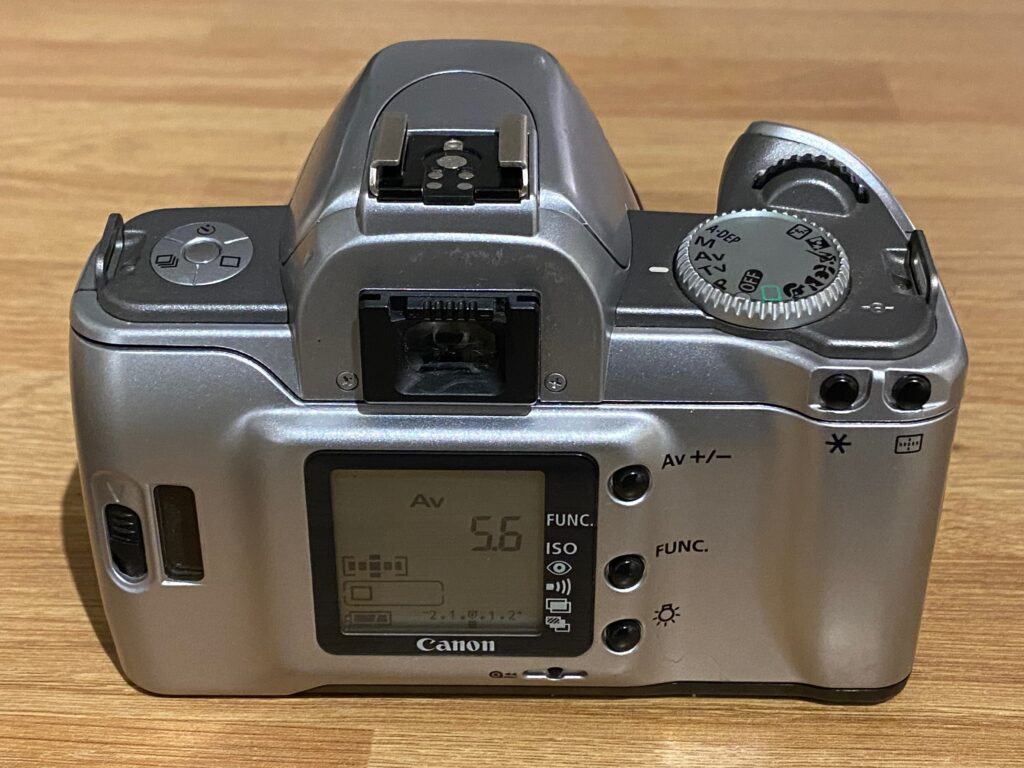
Round the back, there are numerous developments and not all of them are for the better. The dedicated shooting mode buttons of the V are now part of a function menu. There’s a lot to be said for buttons that have a specific purpose, especially when you want to just pick something up and use it without really thinking or, worse, consulting a manual.
Having said that, as is usual with Canon bodies, the controls and how they work are either familiar enough or obvious enough to work them out with a little trial and error. Setting the ISO to push film was really easy, as was setting the shooting mode, AF point and AF mode. After those things were set, I had no cause to go in to the menus again other than after a film change.

What’s interesting is that changes to bodies like this are not trivial decisions made on a whim – they actually start to add up for manufacturers. If you can make use of parts from other models, or the previous model, then you do because the moulds, tooling and equipment are already in place – its paid for. Every new part created has costs in the design, tooling and production phases. Every button moved or added is a change in wiring, the plastic casing, the electronics underneath and potentially the software that controls the camera.
For a camera which was end of line and cost conscious, it’s surprising that when you look closely almost every aspect of the 300X was redesigned. Canon engineers really put the hours in to take the learning from the 300V and the recently released 300D to create something that they believed was a genuine improvement. That’s quite the dedication and the calculations must’ve shown that it’d recoup these costs in terms of sales. I’d love to know how many they sold!
The 300X in use

The question we’re really here to answer is, “is it any good?”
The answer is complicated. I thought this review would be mostly repetition of the 300V review being as they’re such similar devices. However, there are some differences that I didn’t expect to come across.
In the hand, the camera is light and comfortable to hold for prolonged periods of time when coupled with a suitably light lens. I abandoned using a camera sling with it after a few minutes and resorted to just hand holding it for over an hour without any problems. This isn’t like the 1n which makes you feel like your arm is about to drop off after five minutes off a strap or sling.
Using the classic 50mm F1.8 makes it a very compact package, the only disadvantage being that occasionally you will find your fingers straying in front of the lens because there’s nowhere else for them to go. As is the case with many entry level bodies, attaching more expensive, larger and heavier lenses creates a real imbalance which feels a little silly, although will still work exactly as it should.

The control dial on my particular copy needs a spray with some contact cleaner as sometimes it’ll go either backwards or completely crazy when you spin the wheel. This isn’t a fault of the camera, it’s just age and neglect which is to be expected when using any electronics of this age.
I spent the day in aperture priority mode, usually between F4 and F8. When doing this I like to periodically check what shutter speed the camera thinks is reasonable, especially when walking between changing light conditions. As the 300X has a massive LCD on the back, I repeatedly made the mistake of thinking that after a half press the shutter speed would appear but it does not. I can understand the logic here, you’re meant to be looking through the viewfinder and reading the small green display, but it just felt like it should be there and would’ve been very handy.
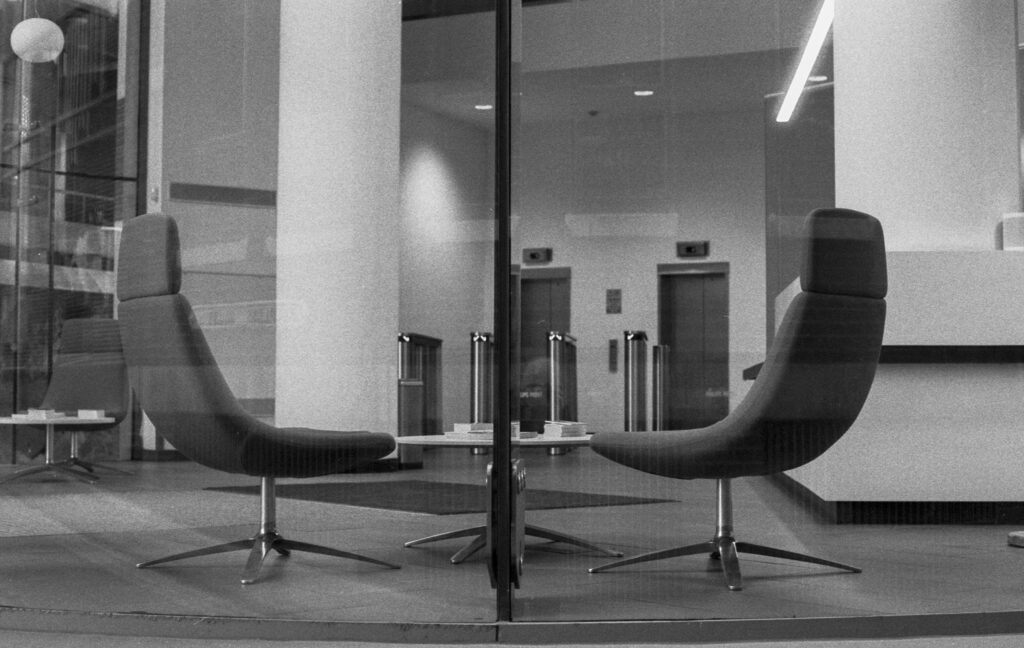
Auto focus never really let me down and was quick and reliable in most circumstances as you’d expect later Canon models to be. I didn’t experience any hunting but missed a couple of shots because it simply wasn’t quick enough to lock on to a subject.
I am now going to completely contradict my earlier complaint about the 300V, which is that you cannot control the auto focus mode and it is always in AI-AF mode, meaning if a subject moves, it begins tracking.
I have always shot my cameras in one shot auto focus mode. I don’t know why – it is simply a habit. When I reviewed the 300V I was taken aback by just how many shots it had nailed the focus on and how accurate it had been in use. I now have to eat humble pie, my hat and admit that this is clearly because it was very quickly detecting moving scenes and adjusting the focus for me. This also makes me think that I am a total moron for not perhaps considering that AI-AF has its place on the streets.

The only place AI-AF doesn’t work is if you’re in to focus and recompose, which is something that I do make a lot of use of (when I take the time to consider a composure rather than just rattling off shots). I can’t help but feel that maybe Canon made the right choice with the 300V when you consider the target audience for these types of cameras.
There really isn’t anything wrong with the auto focus on the 300X and nearly all the mistakes really were my fault. It’s a decent, capable system that is good in anything but the most quick draw/quick fire situations.

In my original review posted in January 2023, I stated the following:
One thing that I can’t explain, however, is the metering. The 300X seems to consistently err on the side of over exposure and is confused by anything which contains strong contrasts or a mixture of lighting. I have no proof, but I would not be surprised to find that the metering algorithm is different in the 300V to the 300X.
Sadly, I achieved so many over exposed shots in different lighting conditions that I cannot simply put it down to user error or bad luck. Most of the time the chosen shutter speed seemed within sane levels so I thought nothing of it, but I have genuinely never used another Canon body which has produced this many incorrectly exposed images.
Is this the 300X or just my copy? This is the difficulty of reviewing old and, these days, expensive cameras – I have no reference to compare against. It’s possible that my meter could well be in need of calibration, but then it did produce several images that were absolutely bang on. An intermittent fault, perhaps?
Update: May 2023 – This is not a fault of the 300X. It turns out my film scanner was throwing the results of perfectly exposed negatives. Having now put several more rolls through the 300X I can confidently say there is nothing at all wrong with the metering on these cameras and it has become one of my go-to street bodies.
Conclusions and learning

So, should you buy one?
On a pure price to performance measurement, this camera is not worth it. The current market price is massively over inflated. If I were making recommendations, and it comes down to this or the 300V, I’d recommend the 300V every time.
I loved using the 300V and the 300X was no exception. They are really well thought out, well designed cameras that are packed with just enough features to make them almost perfect all rounders. The AF in these bodies is unrivalled amongst lower end Canon bodies.
Furthermore, they are both superb compact travel and street photography bodies. With a 50mm lens I really did feel like I blended in to the background a lot more than when I’m usually waving a 1n around the place. The shutter noise too is fairly quiet.

The 300X and 300V are, in my opinion, little ergonomic wonders. If I could only take one single camera with me on a holiday, for example, I’d take a 300V with a 50mm f1.8 without hesitation. You’ve got all day comfort with pretty much all the features you need. I appreciate the 1n every time I go back to it and that remains my go to body when I’m not testing out other cameras, but these last of the line Canon’s have a place in anyones film collection.
After giving the 300X a decent outing, I can’t help but feel like I’ve made a mistake, though. Knowing I had a 300X on the way, I recently passed on my 300V to a new owner. I thought that the X would outshine the V so much that I wouldn’t miss it. In many ways it does, especially in terms of features at least, but this experience leaves me in the awkward position of actually wanting my 300V back.

I’ve now owned, tested or experienced pretty much every significant camera the EOS lineup ever had to offer and I think this finally settles the debate about how many bodies anyone really needs, which ones to keep and which to pass on. For my needs, the absolute dream lineup is the 1n (admittedly with the standard grip), the 50 or 55E and the 300V. The 1n is the workhorse, the default body when I want results every time, the 300V is the obvious “holiday on a plane” camera and the 50… Well, I just have such a soft spot for it I can’t let it go.
The 300X, in retrospect, was a thoughtful end to the EOS era. Canon didn’t just pop out a copy and paste camera with some features turned back on in software. When examined in detail it reveals the little tweaks and changes that make a difference. It is clear that a lot of effort was spent on trying to make this the ultimate entry level experience that would feel familiar to photographers growing ever more used to the conveniences of a digital world. Did they succeed? They probably did.
But is it the best of the best, worth a hefty £80+ asking price?
No. Not today. Buy a 300V instead – it won’t be sticky on delivery either.
Share this post:




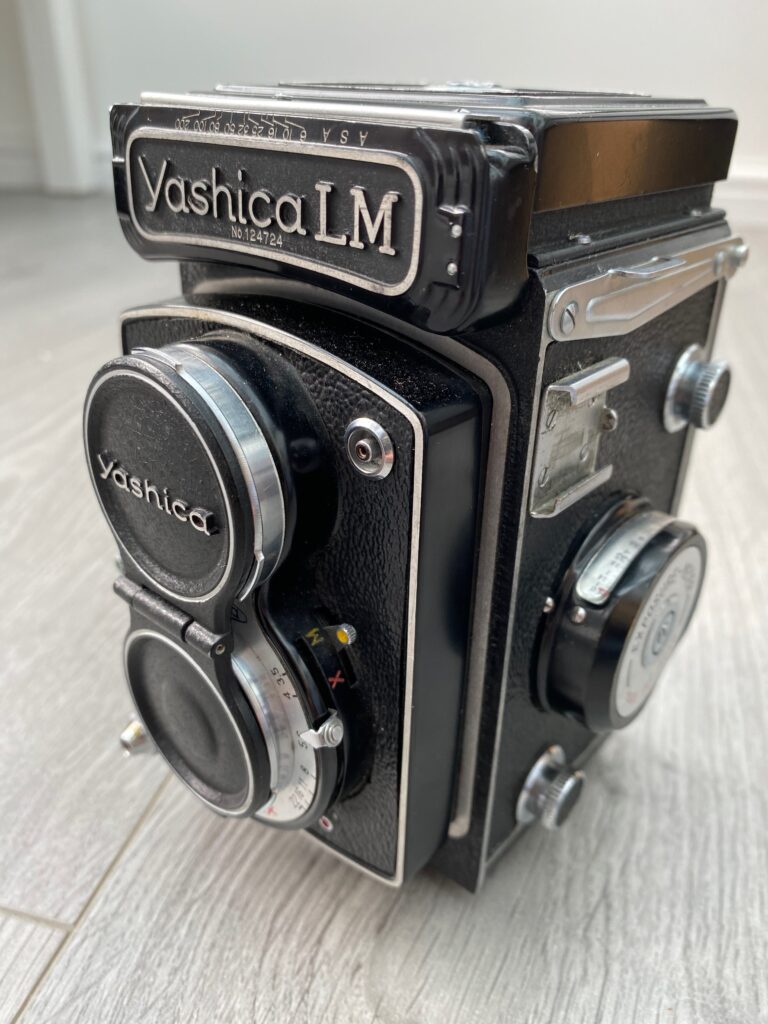
I too have owned and shot the “advanced amateur” EOS XX in just about every line in the EOS film range, but I’ve settled on only 3 bodies to keep; the 3, 30 and 300X.
I do prefer them to the earlier models because at the end of film it appeared that Canon decided to cram just about every advancement it had ever made into the “3” line – the ‘bee swarm’ eye tracking autofocus on the 3 still thrills me when I turn it on!
And the 300V / 300X are little marvels of precise autofocus and great exposure. I bought a 300V to get my daughter away from 90s point and shoots, and she’s never looked back, so I bought the 300X as my street SLR for a similar bargain price – they can be found just like the bargain DSLR examples you blogged about.
After reading your 300V review I’m pleased you tried out the X – I do think it has enough about it under the hood to make it worthwhile tracking down a bargain example.
Thanks for reminding me about the fun to be had with an inexpensive film camera.
Since I wrote the reviews of the 300X and V there’s been a lot of love for these cameras. Coming so late in the lifetime of film SLR’s its no surprise really that they were so capable. I’m convinced the 300X focus system is identical to the 350D and in many ways it performs just like a film version of that camera. If the 350D had the ergonomics and handling of the 300X it’d be so good. The 300X is now my go to street film body, it does everything you want and it does it on a compact, well built and well featured body that should last as long as we are able to buy film.